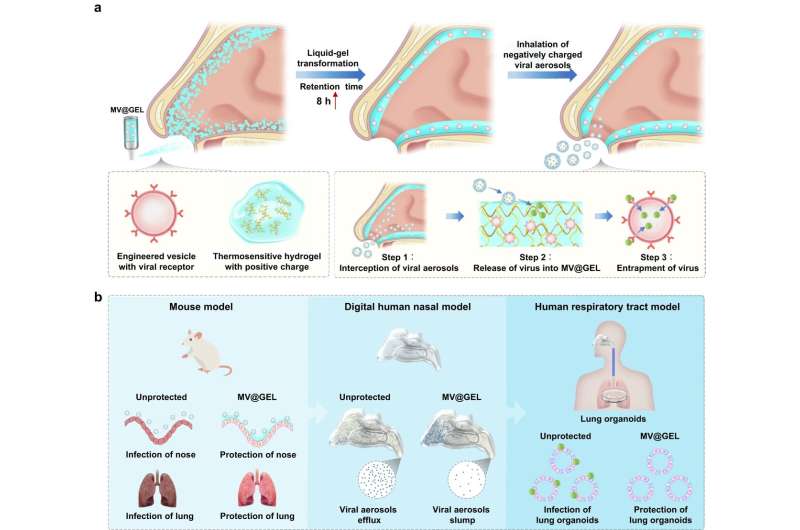This article has been reviewed according to Science X's editorial process and policies. Editors have highlighted the following attributes while ensuring the content's credibility:
fact-checked
peer-reviewed publication
trusted source
proofread
Researchers develop novel intranasal mask to protect respiratory tract from viral aerosols

Researchers from two State Key Laboratories in Institute of Process Engineering (IPE) of the Chinese Academy of Sciences have developed a novel intranasal mask to protect the respiratory tract from viral aerosols. It showed satisfactory protection in a mouse model, digital human nasal model, and human respiratory tract model.
The study was published in Nature Communications.
Respiratory infectious diseases massively impact global public health. The spread of these infectious diseases substantially relies on the transmission of aerosols to the respiratory tract. Utilizing face masks has been an important public health effort to reduce the rates of respiratory infections. However, the effectiveness of face masks is not sufficient for high-risk individuals.
To increase protection against viral aerosols, the researchers designed an intranasal mask (MV@GEL) that comprises a positively charged thermosensitive hydrogel and cell-derived microsized vesicles featuring viral receptors.
"The intranasal mask can be sprayed into the nasal cavity at room temperature and quickly transforms from the liquid state to the gel state at body temperature. Inside the nasal cavity, the positively charged hydrogel can intercept the negatively charged viral aerosols that present in the airflow, while the receptor on the vesicles can interact with the virus that is released from viral aerosols to MV@GEL, thereafter mediating the entrapment of the virus for inactivation," said Prof. Ma Guanghui from IPE.
Upon displaying matching viral receptors, the intranasal masks showed satisfactory protection of the nasal cavity and lungs of mice from either SARS-CoV-2 aerosols or influenza A virus aerosols.
Using computerized tomography images of the human nasal cavity, researchers constructed a digital human nasal cavity model with which to conduct a computational fluid dynamics simulation.
"The simulation result showed that the intranasal mask could intercept 93.2% of viral aerosol particles in the nasal cavity, thus preventing those viral aerosol particles from entering the downstream lung," said Prof. Wang Limin from IPE.
Additionally, researchers used 3D printing technology to fabricate an apparatus simulating the human nasal cavity. It was then connected to a culture of human lung organoids and provided respiratory airflow by a pump, thus serving as an integrated human respiratory tract model.
Using this integrated model, which anatomically replicated a human nasal cavity and closely mimicked infection in the human lung, researchers confirmed the potent protection offered by MV@GEL against viral aerosols and the great suitability of an intranasal mask in humans.
"The intranasal mask in our study can provide broad protection against multiple viral variant aerosols. This is because the binding of virus and viral receptor is independent of mutation," said Prof. Wei Wei from IPE. "Considering the viral receptor on the vesicle could be engineered easily, our MV@GEL system has the promising potential to be a flexible platform against various viral aerosols."
A peer reviewer from Nature Communications called the research "very interesting and exciting" and said that "the proposed strategy could significantly improve the prevention of these infectious diseases and have a high impact on public health."
More information: Xiaoming Hu et al, Intranasal mask for protecting the respiratory tract against viral aerosols, Nature Communications (2023). DOI: 10.1038/s41467-023-44134-w



















